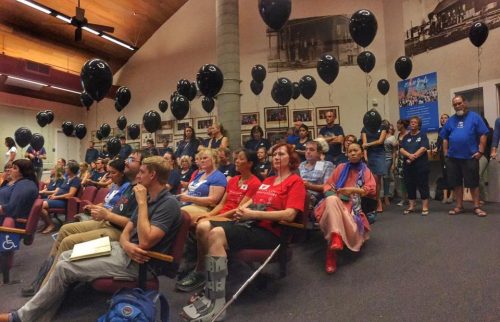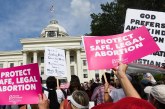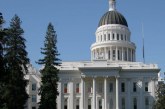
The school board on Thursday night began to look at what it would take to make the district competitive in terms of teacher compensation. No one else has a revenue measure specific to raise compensation for teachers.
Matt Best, Deputy Superintendent of Administrative Services for the DJUSD, explained that 10 percent is our biggest gap, although it fluctuates across our salary schedule.
In order to close our regional average… plus benefits… “we think that closing the compensation gap for all of our employees is somewhere in the three to four million dollar range,” Matt Best explained. “That’s a big number even for a parcel tax.”
Board member Tom Adams asked, “Why can’t we do that within our own existing revenues?”
Mr. Best responded, “Four million dollars if you’re looking at FTE is about 60 FTE. So you’d have to reduce 60 FTE from positions across the district – teaching, staff, administration in order to raise salaries.
“We call it rates and units – if you want to raise the rate, you have to decrease the units because 85 percent of our district general fund budget goes to employee salaries already.”
Tom Adams said, “We would have to reduce the services to our students… The bottom line is it’s not laying off people, eliminating positions, it’s asking our 
students to deal with less services. Somebody is going to get hurt and it’s probably going to be them.”
The district figures that $100 per year in parcel taxes generates about $1.5 million in revenue for the school district.
Matt Best explained that raising the pay by one percent per employee would cost the district $700,000.
How did we get to this point? He explained that right now we get funded at 87 cents on the dollar which goes to core programing – “that’s the bread and butter programs that every district is doing.” Another 11 cents comes from the parcel tax – that’s for very specific things that we can’t fund otherwise.
“That still leaves you two cents less on the dollar than everyone else is getting,” he said. “So you do that over 30 years and less than average funding, and the effect is what we see. It’s exacerbated by LCFF [Local Control Funding Formula] which has accelerated the funding for our neighboring districts – those conditions create this compensation gap phenomena.”
In order to close it, “we need to reduce the services that those 87 cents buy in order to raise the salaries to close the gap.” He added, “It’s doubly difficult because our core funding is already stretched because you can’t cut parcel tax programming to raise employee compensation.”
Madhavi Sunder explained that Davis has about 27 percent low income students, while a lot of the other neighboring districts have a much higher percentage, perhaps upwards of 70 percent. There is just no comparison there with the way that LCFF funds districts. We have identified Rocklin School District as being more comparable to us than other districts in terms of demographics.
“We don’t really have an avenue to increase revenue there, so we need to think about other avenues as well as decreasing our expenditures,” she said.
The board and district talked about ways they could cut money. Matt Best estimated that it would save about 3 to 3.5 FTE or $180,000 to cut seventh period at Davis High School. He estimated another $300,000 if you cut seventh period from the junior highs.
So cutting seventh period would get you less than a one percent pay increase and Matt Best warned, “Maybe. Because sometimes when you make cuts like that there are actually negative externalities that reduce your savings,” he said.
Ms. Sunder explained, “We really have to decide between parcel tax and how much versus how much we can cut and where. And what combination of the two we would want to proceed with.”
If the board put it on the ballot for November 2018, the district would start seeing that revenue in the summer of 2019. “We can’t wait 18 months and do nothing, expecting that the parcel tax is going to pass,” Matt Best said, which means that they will have to figure out ways to cut into the gap before the parcel tax comes on the ballot. He did say that “the parcel tax is the most expeditious way for closing of the gap.”
Alan Fernandes stated, “I want our teachers to be paid better than the surrounding area, that’s my goal. That’s my interest in all of this.” However, he said, “In order to get to third base, we have to get to first base first. That means closing the wage gap. That is the top priority for me and all of the work that we’re doing here.
“I don’t think that any of us have ever suggested otherwise up here,” he said. The question is how.
He asked “can you cut your way to wage gap and cut your way to better pay?”
Matt Best said, “Theoretical answer is yes. But cutting 100 FTE would not be the district that we know.” He said you would have to close schools, have larger campuses and class sizes. We would have to cut the programs that make this district the district that we know. And he said it would take five years to implement.
So the answer: “theoretically yes, my answer is no.”
Alan Fernandes stated: “It could happen but it would fundamentally change the way our district looks and feels and the quality of education we are able to provide.”
Parcel tax is really the only mechanism that a local district has to increase the revenue locally. Superintendent John Bowes stated, “The parcel tax is really the revenue stream to focus on.”
Mr. Fernandes stated, “Before I do a parcel tax, I want to exhaust all our existing remedies.” He said, “Going to the parcel tax option is a serious thing, it’s something we don’t take lightly. It’s going to our community. I for one am not afraid to do it, because I believe we need to do everything we can to close that wage gap.”
He added, “This is one of our best tools – maybe not the only tool. Because tonight’s hearing is not about the cut side, it’s all about the revenue side of the equation.”
He later added, “I think our community supports our teachers and would do it.”
Matt Best pointed out that an important consideration is “time” and “we are in one of the worst teacher shortages this state has known – it’s going to get worse because our universities are not keeping up with the demand of Baby Boomer retirements, our recession of years back really depleted the number of people wanting to join the profession, our state tax funding model is inadequate to foster the type of quality of education we believe in in this town.”
He said our state funding will get worse and, without a parcel tax, “you’re talking five to eight years of hard work just to get us on par – time is of the essence here.”
—David M. Greenwald reporting







The following – from a Donald Bren Foundation-funded report by the Public Policy Institute of California – makes some sense, does it not?
“A tax on square footage, applied uniformly on all parcels, is simple, fair, and equitable, compared to the relevant alternatives,” said Jon Sonstelie, PPIC Bren Fellow, professor of economics at UC Santa Barbara, and author of the report.
It is added that unimproved parcels should probably have lower taxes. But I don’t see the advantage of any of this over a sort of more direct replacement therapy for what was lost via Proposition 13. Could there be some kind of hybrid of the two that is equitable, taking into account those on fixed incomes and whatnot?
But the DJUSD also has three huge mobility gaps that we need to fund:
1 – A priority on student travel by foot or bike has excellent effects, but the lack of a proper school bus system creates a horrid “school drop off” situation that increases risks to students who travel to school by means other than car, and of course this is made worse especially at the elementary school level because schools in Davis do not have geographically-based catchment areas. (And not tangentially, how many students posses proper rain jackets and so on these days?).
2 – The lack of geographically-based catchment, the lack of more than one public high school and free parking for DHS students generates a lot of school trips: The parking lot fills up, or students park in the neighborhood. The ability for some to come by car also creates a particular kind of inequity because some students don’t have the social bonus that a car can provide. Will paid parking help, or is eliminating parking – including implementation of parking permits in areas around schools, and perhaps with exemptions for students with employment outside of town after school – the only realistic one?
Related to both of those, is the DJUSD, parents of students, the students themselves etc. aware that many schools restrict or even prohibit the drop off? (For example three years ago the city of Los Altos received a report from the Institute of Transportation Studies at UC Berkeley which recommended a complete ban on drop-offs on campus.) It’s also highly significant that the safety of routes to school – in particular the design of intersections and crossings and their use by everyone driving – is the biggest reason – see page 11 of this very recent school travel survey in Davis – why many children are not allowed to walk or cycle and are driven instead (which only makes the drop off more dangerous for anyone else not being driven.)
3 – Teachers and staff also have to travel long distances due to lack of nearby affordable housing. Increased compensation will help with this, but still may will travel from out of town or across town. Is there a way to make this more convenient for them and safer for the rest of us? Can funding from an increased tax be used to improve local bus services (or can staff and teachers who live outside of Davis ride school buses with students?) Can we support the use of electric-assist bicycles for teachers and staff for trips within Davis, or at shorter distances in general?
No that does not make sense.
The Davis JUSD encompasses a lot of land outside the City limits. Farmland. Think about that.
Your points regarding the problem of school drop offs, encouraging non-MV trips by or ‘for’ students, etc., are definitely worthy of further discussion.
One of my pet peeves has been Holmes as to drop-off… when parents were asked why they drop their kids off by car, rather having them walk or bike, they almost invariably say that it is because of the number of cars/traffic/safety concerns.
Except for the drop-off behavior, there is little MV traffic anywhere near Holmes. Walt Kelly, speaking thru his cartoon character, Pogo, had it nailed… “We have met the enemy and it is us.”
Howard P(arcel) re: “… uniformly…”. Cherry picking to protect cherry picking? Sure, but I also mentioned “undeveloped land”. Certainly different kinds of land use could affect the formula.
Farmland is ‘developed’, for agricultural purposes… not the same as a vacant/unused parcel… so your definitions do not fit with the basic premise. You quoted,
I do not see the ‘qualifier’ undeveloped… that’s a new spin to what you wrote… a “backpedal”?
The article below discusses a proposal to exempt those without children from paying for school district parcel taxes. It apparently failed to make the ballot last time (and I suspect that it will this time, as well). However, it’s interesting to note that others are at least thinking about this.
Regardless, as fewer households have children in the public school system, there will be less support in general for school district parcel taxes. A natural outcome, if we move toward a more stable population, statewide. (Schools serve communities – not the other way around.)
https://rwcnews.com/newest-california-measure-in-place-30-billion-in-air-as-schools-children-affected.html
If the exemption becomes law, we could change philosophy and go to a ‘tuition-based’ model.
‘Partial tuition’ could also deal with your other issue, Ron.
Please explain/expand.
(Also, note that this isn’t necessarily “my issue”, if a proposed parcel tax is rejected. Perhaps it’s the district itself, which needs to consider alternatives.)
Actually, no it couldn’t. There is no way to compel interdistrict transfer families to pay the parcel taxes. This was made clear to us over and over by the district. So at least they believe it is not possible.
You either accept the interdistrict transfer students and the benefits they bring to the district (ADA funds, ability to keep the surplus of schools open), or you don’t (and deal with the school closures that would be necessary if they weren’t here). Continuing to grouse about the fact that they don’t pay the parcel taxes accomplishes precisely nothing. They can’t be compelled to.
Actually, Howard mentioned a “partial tuition”, not a parcel tax. Therefore, your response did not address that suggestion. (Not sure how that might be implemented.)
Again, this is the school district’s problem, if (yet another) school district parcel tax fails. (And, it’s certainly possible that it would – especially when combined with the other parcel taxes that the city is proposing.)
To be clear… I am adamantly opposed to tuition for K-12 public schools… was just pointing out ‘logical alternative’ if all parcels owned by those who had no school-aged children were allowed to be ‘exempted’.
What a horrid idea this would be! Schools serve us all. If this initiative passed, the psionic blast resulting from everyone wise and decent on the planet simultaneous thinking how stupid this was would sink all the $15 billion aircraft carriers and knock out of the sky all the $250 million jet fighters that the USA uses to protect our freedom to educate our children.
I agree with Todd, this is a terrible idea. I do not have children and yet I have consistently supported school parcel taxes (plus made donations on top of that). It is to society’s benefit to have an educated populace in so many ways that it would be impossible to describe them all. Plus I think it is simply the right thing to do. Children deserve a good education.
And of course the other problem in Davis is that the district allows those from other cities to attend Davis schools, without paying the parcel tax (or an equivalent contribution). An unfair and unreasonable situation, which makes it that much harder to keep requesting increases from Davis households.
Allowing those from other cities to take advantage of Davis schools in this manner also increases/facilitates motor vehicle commuting, to Davis. (Parents driving their kids to school, from outside the city.) Also encourages parents to maintain their connections to Davis (e.g., employment), further increasing motor vehicle commuting to Davis.
Two questions:
1. “there are actually negative externalities that reduce your savings,” he said.”
Does anyone know what these negative externalities consist of ?
2. In thinking of ways to maximize current resources, has there been any consideration of reducing the number of hours of some high school classes to be more in alignment with the way classes are conducted at the college level with a class being offered for example to a group of students on Mondays and Wednesdays and the same class being offered to a different group of students on Tuesdays and Thursdays with Friday, 7th period, being reserved for “office hours”. This would have the advantages of 1) Introducing students to a program that requires more individual responsibility for learning 2) Offering more students access to the same material with the same number of instructor hours 3) Smaller individual classes 4) No increased cost.
If this already exists, please someone feel free to tell me to sit down and shut up until I have informed myself.
Hi Tia – What you’re describing sounds like block scheduling. The goal of block scheduling is to create fewer, but longer class periods with class subjects offered on alternative days.
If Davis school attendance was restricted to children living in the Davis School District, what would that look like? Would we have smaller class sizes, provide more opportunities for Davis kids, or be able to pay a higher salary to our teachers? Do our kids benefit from the higher enrollment or not?
Good question, Sharla. Also, is it the goal of Davis schools to serve other communities (who don’t pay their share, and which encourages motor vehicle commuting)? If a given community has fewer children over time, should a school district pursue outside enrollments (with the expectation that the host community will continue to pay a disproportionate share of costs)?
Do schools exist to serve the community, or is it the other way around?
No.
It is very likely that DJUSD would have to close one elementary school and would certainly have to lay off staff if all of the interdistrict transfers were cancelled.
The reason they have so many is because they over-built in the 1990’s. Population growth of school-age kids has not kept up with their projections. So they fill the slack with interdistrict students.
That is not the purpose of interdistrict transfers.
Maybe so. If parents want to keep them open, perhaps they need to open their own wallets in some manner.
I guess we’ll see, if the district keeps pursuing parcel taxes (and if a proposal fails). Not sure if it’s at that point, yet. (But maybe so, when combined with all of the other proposed parcel taxes.)
The reason they have so many interdistrict transfer students is because they over-built schools in the 1990’s. The schools were overcrowded then. They threw out most of the interdistrict students due to overcrowding. Based on their projections for enrollment increases, the district built another elementary school in South Davis and another one in east Davis, then closed Valley Oak. They also built the third junior high school.
But the growth in the student population did not occur at the rate they had projected, basically because Davis stopped growing almost entirely. So they barely have enough students to keep the current number of elementary schools open. There is a minimum number of students required (450 or so, if I recall) to make a school site viable. They gradually began allowing more interdistrict transfers because those students help them fill seats in schools that would otherwise be subject to closure. If you were here when Valley Oak got closed, you’ll understand how difficult that process is. It caused a huge uproar in the community.
I hope that clarifies things.
Oh, and let’s not forget the problem of school district parcel taxes being exactly the same amount for a single family dwelling (vs. an entire apartment complex).
At some point, voters may reject this system. (Even in “education-friendly” communities.)
So they’re looking at a $200+ parcel tax.
In addition to all the others (DJUSD levies)… but that is only to get to median in 2017… by the time it goes into effect, if passed, we’d still be behind the ‘then’ curve… less than $400 would be irresponsible, lest we need another parcel tax vote 2 years hence. And, apparently one board member wants to go ahead of the median, as well… maybe we should make it $500… less than $42/month!
Prediction… City of Davis will respectfully defer any parcel tax measure until DJUSD gets theirs resolved. Has happened several times before over the last 30 years…